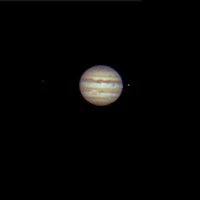The Pleasures of Jupiter
September 2009 :
Note: This article may contain outdated information
This article was published in the September 2009 issue of The Skyscraper and likely contains some information that was pertinent only for that month. It is being provided here for historical reference only.
As you may recall from an earlier column, I reported that the United Nations General Assembly had designated 2009 as the International Year of Astronomy. This year-long celebration was designed and initiated to focus attention on astronomy — 400 hundred years after Galileo first trained his telescope on the heavens.
And one of the first heavenly objects Galileo observed was Jupiter. On January 7, 1610, Galileo observed Jupiter through one of his improved 30 power telescopes. He noticed three smaller bodies in Jupiter’s vicinity arranged in a straight line. After watching Jupiter for several nights he noted that the positions of these bodies changed. And soon a fourth one became visible.
Galileo realized that these bodies were moons orbiting Jupiter. Two months later Galileo published his observations in Sidereus Nuncius (Sidereal Messenger): "I therefore concluded, and decided unhesitatingly, that there are three stars in the heavens moving about Jupiter, as Venus and Mercury around the Sun; which was at length established as clear as daylight by numerous other subsequent observations. These observations also established that there are not only three, but four, erratic sidereal bodies performing their revolutions around Jupiter."
Today those four moons are called the Galilean moons or satellites in Galileo’s honor.
These observations proved the Earth-centered view of the universe (Aristotelian view) was incorrect. The Jovian system was a solar system in miniature. The Sun, like Jupiter, was at the center of the system (Copernican theory) with the planets revolving about it.
If you want to observe Jupiter with your own telescope you first need to know where it can be found in the sky. Monthly magazines, sky charts and many web sites provide this information. But on September 2 you can let the waxing gibbous Moon be your guide in the southeastern sky. Jupiter will be just two degrees (about four full moon diameters) to the lower right of the Moon.
This sky scene will be quite beautiful to the naked-eye. But before you focus your telescope on Jupiter (and/or the Moon); try observing the pair with binoculars. The Moon will be quite bright. If you have a pair of 10 X 50 binoculars you can even spot one or two of Jupiter’s moons. However, to appreciate all the beauty and dynamic events this system has to offer requires a telescope.
Even if you have a small inexpensive telescope, your optics are much better than those Galileo used to conduct his observations. Your telescope mounting may be rickety, making it difficult to keep Jupiter centered in the eyepiece, but the optics are capable of providing a fair to good image.
And one of the first things that will catch your eye will be Jupiter’s Galilean satellites. They are: Io, Europa, Ganymede and Callisto. When two or more are visible they line up in the plane of Jupiter’s equator. While these satellites parade around Jupiter many interesting events occur for us earth-bound astronomers to observe.
When a moon passes in front of Jupiter and casts a shadow onto the Jovian cloud tops, it is called a transit. Besides seeing the satellite's shadow, you may also see the bright disk of the satellite traversing Jupiter's clouds at the same time, though this event is more difficult to observe. A moon may also pass behind the planet, which is called an occultation. Jupiter's shadow can even eclipse a satellite as well; gradually the moon will either blink out or reappear. Also, it's fun to watch all four moons line up on one side of the planet. As you can see there's much to observe in Jupiter's vicinity.
In addition, you'll easily notice the more prominent dark bands/belts and lighter zones in Jupiter's cloud tops. The once dominant feature of Jupiter (from at least Galileo's time thru the mid 1970s) was the famous Great Red Spot (GRS). It is nothing more than a giant storm in Jupiter's clouds that has been active for more than 400 years. Unfortunately the storm’s not as red or great as it once was, so it might be difficult to detect in smaller instruments without special filters to enhance the image. In recent years the red coloration has come back somewhat, making the GRS a little easier to see than it had been for 15 years or more.
And did you hear that Jupiter was struck once again by a comet or asteroid on July 19? Fifteen years ago over 20 fragments of Comet Shoemaker/Levy-9 slammed into Jupiter’s cloud tops leaving impact scars, some of which persisted for weeks. This time the object (one estimate pegged it at about _ to _ mile wide) left an impact scar about the size of the Earth. Poor weather here in New England prevented us from viewing the aftermath of this collision.
So you never know what to expect when observing Jupiter. I guess the mantra is: expect the unexpected!”
Keep in mind that Jupiter rotates once in 10 hours, making it possible to see the entire planet in one or two nights of observing. Even under low magnification the view will be rewarding.
You can get some splendid detailed views of Jupiter and his moons through the telescopes at Seagrave Memorial Observatory (http:/www.theskyscrapers.org) on Peeptoad Road in North Scituate every clear Saturday night. Or visit Ladd Observatory (http://www.brown.edu/Departments/Physics/Ladd/) on the corner of Hope Street and Doyle Avenue in Providence every clear Tuesday night. Check out their websites for the public night schedules. There is no admission fee to these facilities on those nights.
Knowledgeable astronomers will be on hand to share their love of the heavens with you.
As always, keep your eyes to the skies.




